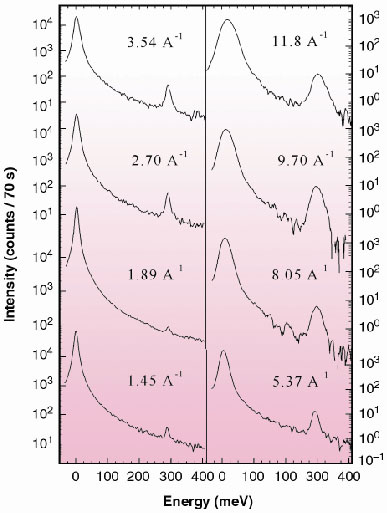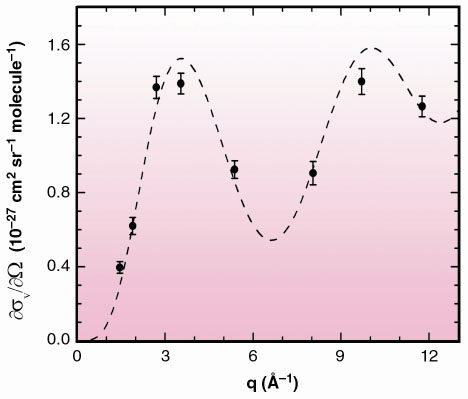- Home
- Users & Science
- Scientific Documentation
- ESRF Highlights
- ESRF Highlights 2001
- Collective Atom Dynamics
- Molecular Vibrational Spectroscopy by Inelastic X-ray Scattering: the Case of Liquid Nitrogen
Molecular Vibrational Spectroscopy by Inelastic X-ray Scattering: the Case of Liquid Nitrogen
The vibrational properties of condensed matter are routinely studied by Raman scattering and infrared absorption techniques, which generally ensure a high signal-to-noise ratio together with high resolution. With these spectroscopic methods, it is generally easy to obtain precise information on the frequency position of the vibrational bands and then to compare them with theoretical models. Nonetheless there are cases where additional information is required in order to interpret the vibrational spectrum correctly (e.g. its spectral intensity, or the dependence of the vibrational excitations on the wavenumber). In such cases, where the mentioned techniques are not very helpful, the neutron scattering technique has already proven to be an important tool [1]. Here, we want to show that the inelastic X-ray scattering (IXS) technique can provide similar and complementary information with respect to neutron scattering. For this purpose, we present the results of an IXS study of the vibrational band of liquid nitrogen.
The experiment was carried out at beamline ID16 using the vertical arm spectrometer for the scattered energy analysis with an instrumental energy resolution of 10 meV (FWHM). IXS spectra were collected in the 40-400 meV exchanged energy range for several values of the exchanged momentum, q, comprised between 1.45 and 11.8 Å-1. The nitrogen sample was kept at a temperature of (76 ± 0.2) K and at a pressure of (1 ± 0.1) bar. The final spectral intensities (Figure 79) are characterised by two distinct features: a central band and a much weaker band at high energy. The peak position of the latter band corresponds to the stretching energy of the nitrogen molecule at 289 meV, while the former band is due to the roto-translational dynamics of the molecule. As a general consideration, the capability of IXS to access the vibrational dynamics in the condensed phase, recently demonstrated at one q value for the case of the O-H stretching band in liquid water [2], is here clearly confirmed in a broad q range for the case of liquid nitrogen.
 |
Fig. 79: IXS spectra of liquid nitrogen at several values of the exchanged momentum, q. The spectra are reported on a semilog scale in order to emphasise the weak vibrational band at ~289 meV. |
The relative intensity of the vibrational band with respect to the total spectral intensity, Sv(q) / S(q), can be readily worked out from the experimental data. Moreover, values for the total spectral intensity S(q), which corresponds to the atomic structure factor, can be obtained on an absolute scale. Therefore, the absolute scattering cross section per unit solid angle, , for the vibrational excitation,
v (q) /
= ro2fq2 Sv(q) (ro classical electron radius; fq atomic form factor), can be determined (Figure 80). These data can be compared with a semiclassical calculation where the correlations among translational, rotational and vibrational degrees of freedom were neglected an approximation which is very well suited to the case of liquid nitrogen. The result of this calculation is also reported in Figure 80, and compares well with the experimental data. This demonstrates i) the good accuracy which is currently obtainable with IXS for the determination of the absolute cross-sections of vibrational excitations in a large q-range, and ii) how direct the comparison between experimental data and theoretical calculation can be made given the simplicity of the expression for the IXS cross-section.
 |
Fig. 80: q-dependence of the absolute cross-section per unit solid angle for the vibrational excitation of liquid nitrogen (full circles). The result of a theoretical calculation made in semiclassical approximation is also reported (dashed line), and compares well with the experimental data. |
References
[1] S.W. Lovesey, Theory of neutron scattering from condensed matter, Clarendon Press, Oxford, Vol. 1, 239-282 (1986).
[2] C. Halcoussis, T. Abdul-Redah, H. Naumann, G. Monaco and C.A. Chatzidimitriou-Dreismann, ESRF Newsletter 34, 17 (2000).
Principal Publication and Authors
G. Monaco (a), M. Nardone (b), F. Sette (a) and R. Verbeni (a), Phys. Rev. B, 64, 212102 (2001).
(a) ESRF
(b) Universita' di Roma Tre, Rome (Italy)



